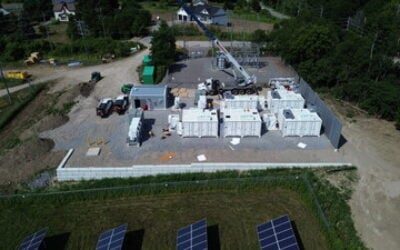
Utility NV Energy has had plans for three large-scale solar-plus-storage projects approved by regulator the Public Utilities Commission of Nevada (PUCN) which the company said will enable it to achieve a PUC-set energy storage deployment target.
NV Energy filed plans for the three solar farms in July as part of its integrated resource plan (IRP), as first reported by our sister site PV Tech. Comprising 478MW of solar PV and 338MW of battery storage, the utility said today that the addition of the projects brings NV Energy’s portfolio of solar and storage projects in service and under development to 2,669MW of new solar and 1,028MW of storage.
The PUCN target was set in March this year and mandated for NV Energy to deploy 1,000MW of energy storage. Nevada became the sixth US state to adopt such a goal, although Virginia has since become the seventh.
Notably, all three of the projects approved by PUCN yesterday include four hours of battery storage duration. NV Energy said in a press release that it will use the batteries to store cheap solar energy during the day and discharge it into the evening. The projects are scheduled to come online before the end of 2023.
Try Premium for just $1
- Full premium access for the first month at only $1
- Converts to an annual rate after 30 days unless cancelled
- Cancel anytime during the trial period
Premium Benefits
- Expert industry analysis and interviews
- Digital access to PV Tech Power journal
- Exclusive event discounts
Or get the full Premium subscription right away
Or continue reading this article for free
PUCN also approved a community solar project at a high school which will be the first project developed through Nevada legislature’s Expanded Solar Access programme, which requires the utility to expand solar access for low-income and disadvantaged communities. A plan to expand transmission lines also filed by NV Energy in its IRP is still under review by the PUCN.
In October NV Energy also filed a request for proposals (RfP) for “major additions” to its renewable energy portfolio with solar, geothermal, wind, biomass and biogas technology projects compliant with Nevada’s existing renewable portfolio standards to be considered, while the utility said it would also consider proposals for both standalone energy storage systems and generation projects co-located with energy storage.
The three approved projects:
| Project name | Generation capacity | Battery storage output and capacity | Location | Developer |
|---|---|---|---|---|
| Dry Lake Solar | 150MW solar PV | 100MW four-hour (400MWh) | Clark County, Nevada | NV Energy |
| Boulder Solar III | 128MW solar PV | 58MW four-hour (232MWh) | Clark County, Nevada | 174 PowerGlobal + KOMIPO America |
| Chuckwalla Solar Project | 200MW solar PV | 180MW four-hour (720MWh) | Clark County, Nevada | EDF Renewables North America |





